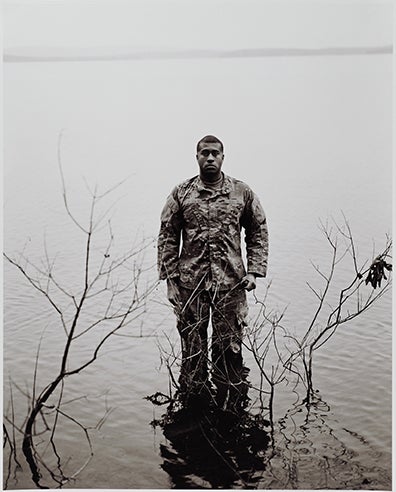Ed Drew grew up in Brooklyn, New York City and joined the military two days after his 18th birthday and completion of high school. He served six years of active duty in the Air Force as a C-130 jet engine mechanic assigned to an airbase near Tokyo and it was while in Japan he discovered his nascent passion for other cultures and began his journey as an artist.
In 2009 he joined the California Air National Guard and during training as a Combat Search and Rescue helicopter gunner he also attended San Francisco Art Institute, receiving a BFA in Sculpture with a minor in Photography. Deploying to Afghanistan in the spring of 2013, he created his first major body of work there by using a large-format camera to capture tintype portraits of fellow soldiers in an active combat zone. Many of those unique images are now part of the permanent collection in the Smithsonian American History Museum.
After his discharge from service in Afghanistan, Drew relocated to Little Rock, Arkansas to be with his extended family and relates his story of the making of Self Portrait in Arkansas:
“Initially I created this body of work to address my longing to return to uniform, to regain my identity, after ending my military contract to be a stay-at-home parent. Having relocated to Arkansas, a heavily forested southern state, I often found myself hiking in the woods, introspectively reflecting on my past and America's past.
For the series I employed a field view-camera, reminiscent of older style cameras that required a pneumatic bulb to trip the shutter. I purposefully showed the device’s cord to indicate that the image was being made by my own hand. While alone in the woods I often carried a gun in my belt. My identity as a veteran, and living in the South, often made me consider the historical relevance of my actions.
Barefoot in each photograph, I am aware that my feet stand possibly in the very same place where my racial ancestors may have hidden, trying to escape to freedom. I do this to connect to them, as most slaves were barefoot. I imagine running barefoot through these woods, away from the overseers in charge of keeping the slaves in line and capturing the runaways. I want to feel the pain and the contrast of soft earth, the leaves, rocks, and dirt. I want that connection to the ground where my ancestors were worked, murdered, and buried. I am reconciling the history of the South and what being in the forests as a black person means historically.
As well as an emblem of strength, my uniform offered me safety. It renders me invisible, camouflaged within the sanctuary of the forest. Why do I fear? This fear has historical precedence. There are many contradictions in fighting for a country's freedoms when that country still, to a point, contends my own race's liberties.
Ed Drew: Self Portrait in Arkansas was curated by Thom Sempere,
JSMA Associate Curator of Photography



